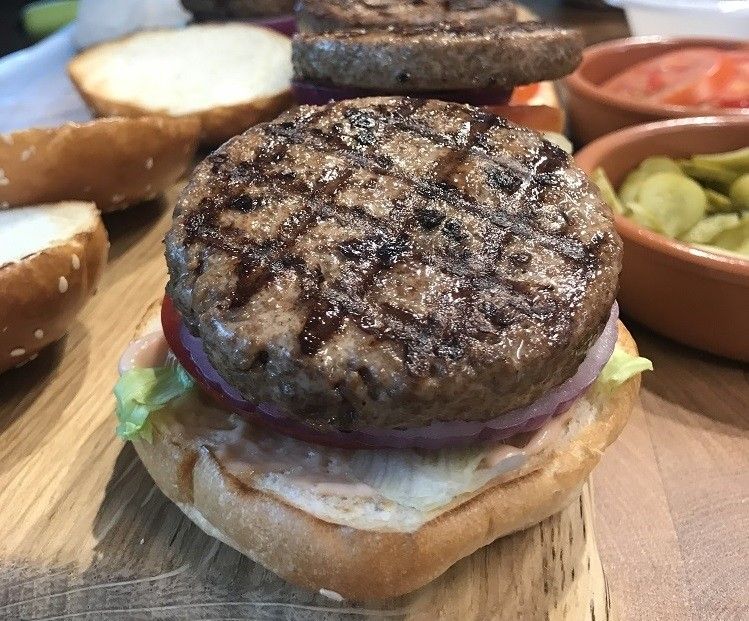Rising consumer retail demand for plant-based proteins has been a pronounced post-Covid trend and has certainly piqued investor interest. For startups hurriedly gearing up to meet this demand, the strategy seems fairly direct: expand processing capabilities as quickly and as affordably as possible. So far, that has mostly meant bigger and more automated central facilities — building them from scratch; buying up and re-purposing them from defunct meatpacking units; or seeking co-manufacturing partners, usually from an existing cadre of veteran protein incumbents.
But is there a case to be made for distributed, hyper-local processing models? SavorEat CEO Racheli Vizman thinks so, and her notion of combining networked 3D-printers that simultaneously print and cook nutritionally customized plant-based products has secured a brace of investments in recent weeks. Two Israeli investment houses — Mor and Meitav Dash — will invest $3 million into her company and will receive options to invest a further $1 million.
The founder of agtech’s first unicorn David Friedberg also believes in distributed, hyper-local food production. Hear his wide-ranging interview with Louisa Burwood-Taylor on the Future Food podcast here.
According to the Israeli business news outlet Globes, “the first $1 million will be invested immediately at a valuation of $13 million and $2 million more will be invested at a valuation of up to $35 million.” And that comes within weeks of SavorEat securing a similar-sized $1.75 million commitment from the Millennium Foodtech Partnership (which held its own TASE IPO earlier in July.)
The next microwave revolution
“This is the next microwave revolution,” Vizman emphatically told AFN by phone while describing her company’s technology and approach. Founded in 2018, alongside her co-founders Oded Shoseyov and Ido Braslavsky, the team at SavorEat has been developing a customised 3D-printer that uses infrared light to cook the burger as it prints. As part of this, the team has been working to apply novel ingredients like nano-cellulose to improve texture. Most of these technologies span out of the Hebrew University’s Faculty of Agriculture, with SavorEat receiving an exclusive commercialization license from the University’s Yissum technology transfer company.
As things stand, the plan appears to be for a network of 3d-printers to be stocked with a bio-cartridge containing plant-based proteins, fats, flavor components, and nano-cellulose — a fiber that can be manipulated into a variety of textures, including those mimicking beef muscle and fat.
A distributed proccessing strategy would have manifold advantages for another 2020 foodtech trend, reckons Vizman: dietary personalization. Simultaneous cooking and preparation would eliminate the need for cold chain storage or excessive preservatives, while allowing each consumer to choose salt, fat, protein, texture, taste or vitamin levels that would fit their specific diet, lifestyle or medical condition. And through automated cooking, she added, there would be less labor cost in restaurants and an easier biocontrol process in the kitchen for an age where consumers are warier of manual disease transmission. For the producer, there would also an advantage over central processors in how much data could be collected on individual consumer dietary and culinary preference.
The technology is also particularly apt in a post-Covid world where online food delivery and ghost kitchens have come into their own as consumers increasingly eat at home. Supply chain disruptions also make localized production important.
Military protein
Offering an outside view of these companies, Brian Frank of FTW Ventures stressed the importance and challenges of sound market research for these sorts of products that have never existed before. “This sort of hardware can be hard to make and hard to sell,” he cautioned. While he doubted if these would appear in even the most luxurious of home kitchens any time soon, he added he would be far less surprised to see these sorts of personalized nutrition printers finding their place in automated quick-serve restaurants, hospitals or even on battlefields.
“An optimum, personalised experience,” he said. “There are institutional needs for that.”
Elsewhere in foodtech and agtech, there have been quite a few early-stage companies making headway with an emphasis on distributed locality. InFarm has its larder-sized vertical farms. Better Origins is designing networks of insect mini-farms. So, why not distributed plant-based food processing in restaurants, hospitals, or even homes? How distant or implausible is the vision of the Star Trek replicator?
Before considering anything close to this, the three “P’s” of 3D-printing need to keep steadily improving — precision, portability, and price.
Nevertheless, there are already some plant-based protein early-stage companies pressing ahead. Inspired by the prospects of 3D-printing for everything from spare aeroplane parts to kidney transplants, startups like Redefine Meat and NovaMeat are both developing ways of simulating the taste and texture of muscle tissue through 3D printing — a harder texture to simulate than burger patties or chicken nuggets.
Space steaks
And with the culturing of animal cells as a protein source, 3D printing is already aiding companies like BlueNalu or AlephFarms to scaffold and build the texture of their steak or fish fillet products. Here, Russia’s 3D Bioprinting Solutions even offers companies like these novel solutions to build out microscopic nibbles of fishcake in zero gravity conditions on the International Space Station.
This is all an offshoot of 3D printing more generally in foodtech — and it will be interesting to see the extent cake or pizza printers like Ohio’s BeeHex or the UK’s ChocEdge pivot into personalised proteins, if at all. Well placed for this sort of transition could be Natural Machines and its magically named “Foodini,” which specialises on developing printed products with fresh ingredients.
For now, although the temptation may be high for self-dependency in light of some of the risks to bottlenecked centralised food supplies, the reality is still that these 3D printer cartridges would have to be filled up somewhere, and are hopefully recyclable.
Any thoughts or tips on 3D printing and foodtech? Let us know! [email protected]




